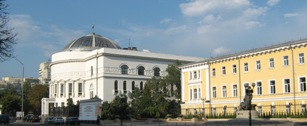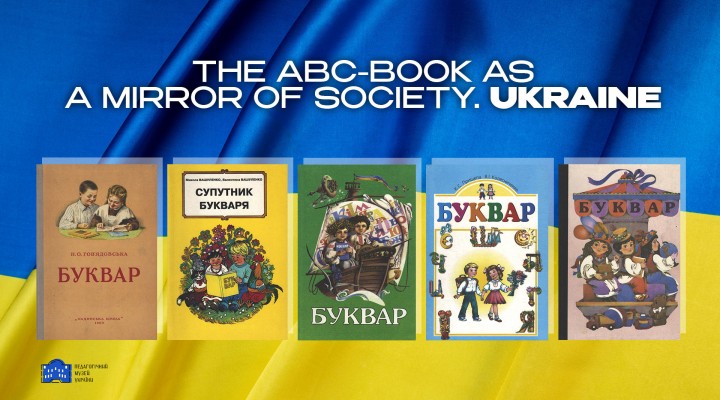Primer by Ivan Fedorov (1574, Lviv) is the First Printed Primer in Ukraine.
The first primer in Ukraine was published in 1574 in Lviv by the Ukrainian book printer and educator Ivan Fedorov. The textbook was printed in Church Slavonic for local schools where the Cyrillic alphabet was taught. The primer was divided into two parts: the first part contained the alphabet and elements of grammar, and the second one contained texts for reading and learning by heart. The texts for reading included prayers from the Book of Hours and excerpts from the Book of Solomon’s Proverbs on moralistic topics. The fact that the textbook contained texts of an educational nature was an absolute innovation in Ukrainian pedagogy of the 16th century. I. Fedorov was the first to try to introduce elements of grammar into the process of teaching elementary literacy, in particular, patterns of conjugation of various verbs that begin with each letter of the alphabet in the present tense. Thus, Fedorov’s Primer went far beyond the usual alphabet. The book was in great demand among Ukrainians. Two copies of Ivan Fedorov’s Primer have survived – in the library of Harvard University (USA) and the British Library in London (UK). The fact that only 2 copies have survived is explained by the fact that the primer is an educational book of small size and format. It was read out quickly.
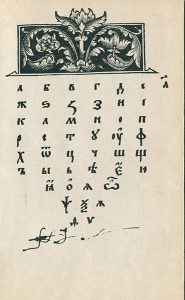 |
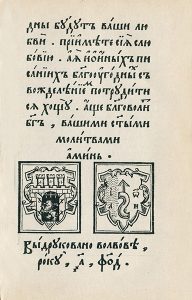 |
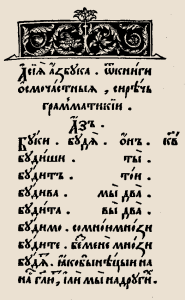 |
The First Period. Primers of the Mid-Nineteenth Century
The oldest primers in the collection of the Pedagogical Museum of Ukraine are rare editions of the mid-nineteenth century: A Primer Compiled in a New Way for Home Science by Yosafat Kobrynsky (1842) and The South Rus Primer by Taras Shevchenko (1861).
Josaphat Kobrynsky’s Primer Compiled in a New Way for Home Science (1842, Lviv) is one of the first printed textbooks for teaching literacy, which uses a civil font and a sound synthetic method of teaching. Yosafat Kobrynsky was one of the first in Ukrainian bookmaking to attempt to use folklore materials in the educational process. The primer is written in the vivid Ukrainian language and contains such works of oral folklore as proverbs, sayings, riddles, and fables. A new and unexpected feature of the Primer was the “Rules for Keeping Your Health” compiled by J. Kobrynsky. In this textbook, J. Kobrynsky applied a new way of learning to read and write, from easy to difficult, combined learning with education, and used visualization.
The South Rus Primer was compiled by the Ukrainian poet and thinker Taras Shevchenko and published at his expense in 1861. The textbook was intended for primary literacy teaching in Ukrainian to children and illiterate adults in Sunday schools. The book contained an alphabet with printed and written letters, texts for reading, numbers, a multiplication table to one hundred, chants of the Psalms of David, and five daily prayers. The primer was innovative because it differed significantly from primers of the time. The texts for reading were works of Ukrainian folklore, which encouraged students to read consciously and comprehend what they read. The Primer was published in an edition of 10,000 copies which was large for those times, and became very popular in Sunday schools in all regions of Ukraine, despite the ban on printing in Ukrainian by the Russian Empire.
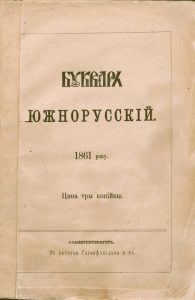 |
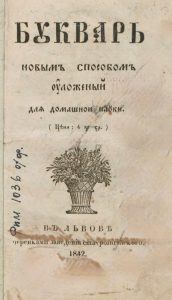 |
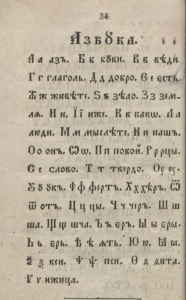 |
The Second Period. Primers of the Early Twentieth Century (before the First World War)
The beginning of the twentieth century was a period of national revival in the history of Ukrainian education and culture. 1917-1921 was the time of the national liberation struggle of the Ukrainian people for the restoration of Ukraine’s statehood. It was the first time in the history of Ukrainian culture that the press and publishing activities developed rapidly. Most Ukrainian primers of the early twentieth century had a clear national orientation, were well compiled from a methodological point of view, and met the interests of the Ukrainian child.
An example of such a textbook is Ukrainian Primer. Based on the textbook by O. Potebnya by Sofia Rusova (1917, Poltava). The primer was compiled by the Ukrainian educator Sofia Rusova. In the preface, the author notes that the textbook is based on an old primer by linguist Oleksandr Potebnya, which he compiled in the 1860s for Sunday schools but did not have time to publish. The author chose Taras Shevchenko’s poems as reading material. The primer also contains the names of days of the week, months, seasons, and samples of calligraphic lettering. From a methodological point of view, Sofia Rusova’s Ukrainian Primer was simple and accessible for children to learn.
An interesting publication of this period is the Ukrainian Primer (1917, Ekaterinodar, Kuban). The primer was compiled by the commission of the Kuban Ukrainian Society of School Education and printed in Katerynodar in 1917. The textbook was published as a part of the Ukrainian cultural and educational movement that operated in the Kuban in the early twentieth century. The Ukrainian Primer contained the alphabet, spelling, and numbers. The texts for reading were poems by Taras Shevchenko and works of folklore.
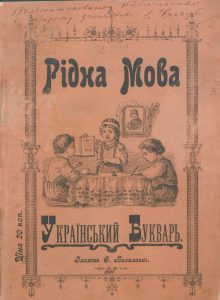 |
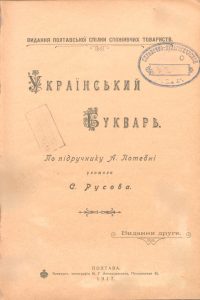 |
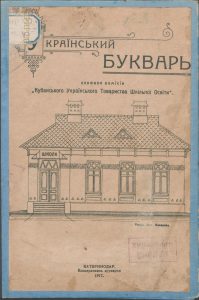 |
The Third Period. Primers of the interwar period (1920s-1930s)
The period of the 1920s and 1930s in Ukrainian schooling was marked by ideological pressure, changes in education, and teaching methods imposed by the Soviet government. Many talented Ukrainian teachers and scholars were repressed; others were forced to create under the pressure of the totalitarian state. In general, few primers were published during this period. The textbooks of this period were ideologized. It was common practice to translate textbooks into Ukrainian from Russian editions. The artistic design was plain, with or without black-and-white illustrations. However, despite the difficult conditions for creativity, Ukrainian teachers tried to create high-quality textbooks for primary school students.
A valuable publication of this period is the Primer (1934, Kharkiv), created by Ukrainian educator Vasyl Pomohaiba in collaboration with his wife Hanna Savytska. The primer contains the alphabet, sample spellings, and small texts for reading, mostly poems and riddles. The textbook pays great attention to color illustrations of the texts, which was rare at the time. The artist was Bulakhovsky. The edition was printed in 50,000 copies.
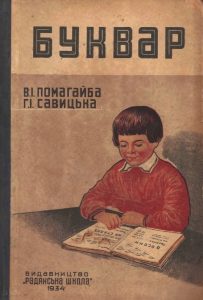 |
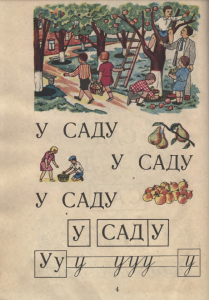 |
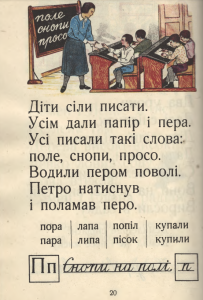 |
The Fourth Period: Postwar Primers (1945-1970s)
This period in the history of Ukrainian book production is marked by ideologization and attempts to denationalize Ukrainian children. It was a tribute to the times that the first page of the readings contained the “Song about Lenin” or the USSR anthem. Nevertheless, the primers became larger, began to be published in large editions, and featured color illustrations, photographic reproductions of paintings, in addition to improved methodological tools. Textbooks of this period were also characterized by a large number of reprints.
An example of a typical Ukrainian primer of the 1950s and 1960s is the Primer by Nadiia Hoviadovska (Kyiv, 1953). The primer was printed on high-quality white paper, had a larger format, and contained a larger number of pages. The textbook contains a large number of black-and-white illustrations and large, readable fonts. The texts for reading are short stories, rhymes, and riddles for children. The primer was published 13 times over 15 years with a total circulation of over 6.5 million copies.
During this period, Lydia Depolovych’s Primer, published 19 times between 1938 and 1956 (a total circulation of over 12.5 million copies), was also used. The methodology of teaching reading and the sequence of learning letters in L. Depolovich’s Primer were so effective that it was adapted for teaching blind children (1948).
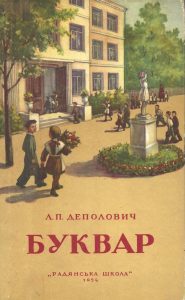 |
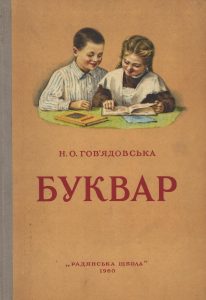 |
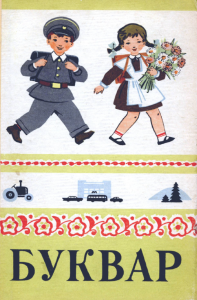 |
The Fifth Period (1980s – 1990s)
In the early 1990s, with the restoration of Ukraine’s independence, a new type of primers began to be created, based on the idea of forming a personality based on national and universal values. The textbooks include modern texts of Ukrainian folklore and the best examples of Ukrainian children’s literature. The texts for reading are full of national symbols, and the editions themselves are richly illustrated. Modern Ukrainian primers in the collection of the Pedagogical Museum are represented by the editions of Mykola Vashulenko and Nadiia Skrypchenko.
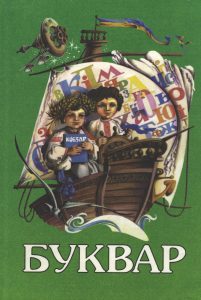 |
 |
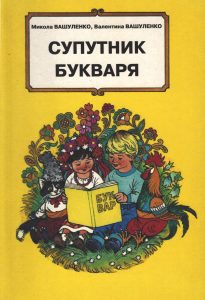 |
Supplement to the Primer by Mykola and Valentyna Vashulenko (Kyiv, 1997)
The Sixth Period. Special Primers
The funds of the Pedagogical Museum of Ukraine contain a special collection of primers for teaching literacy to children with special educational needs. The first such primers appeared in Ukraine in the 1930s. It is important that even then, Ukrainian scientists and educators attached special importance to inclusive education.
An example of such a primer is the Primer for Schools for Deaf and Dumb Children (Kyiv, 1933) (authored by a team led by Bykhovska), a primer for teaching children with hearing and speech impairments. The primer had a large number of visuals and taught sign language. The artwork was created by Ohrim Sudomora, a Ukrainian artist who worked in book graphics as an illustrator of children’s books.
During the Second World War, teachers often made their textbooks for children. An example of such a textbook is the handwritten Primer by Lydia Depolovych, made by a teacher of the Staromykhailivska school in Donetsk Oblast, H. Yevdokymova, in 1944, based on Lydia Depolovych’s primer.
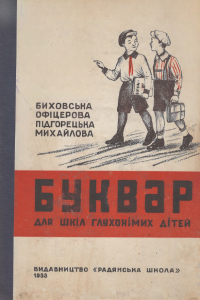 |
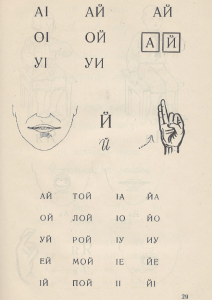 |
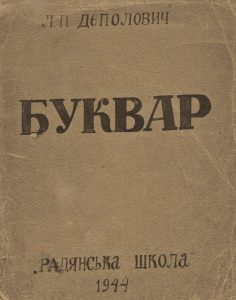 |

